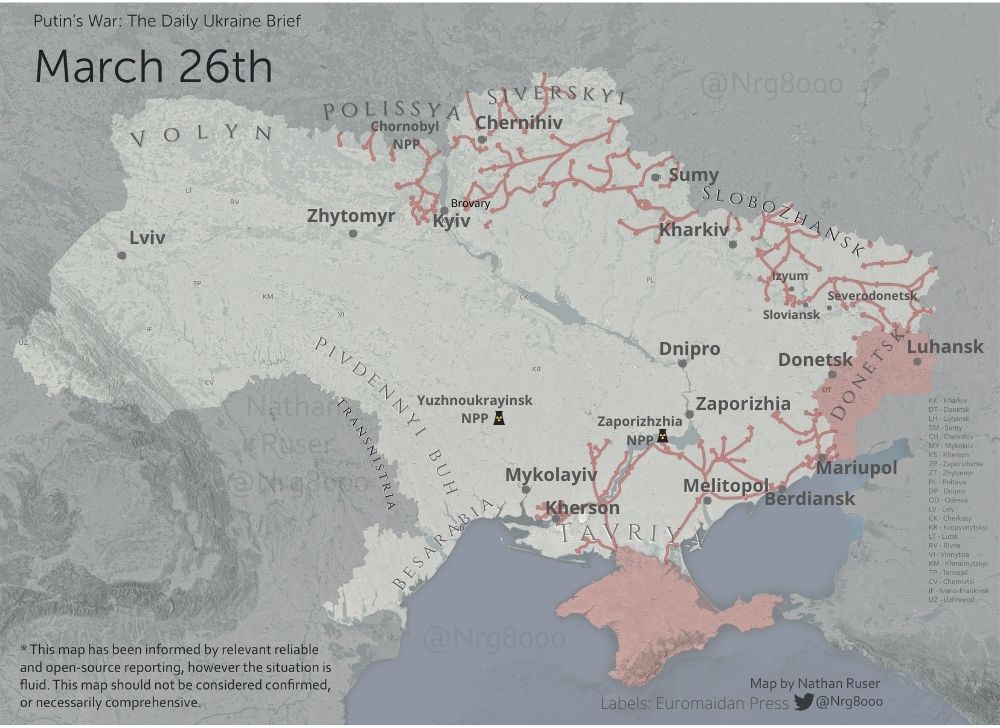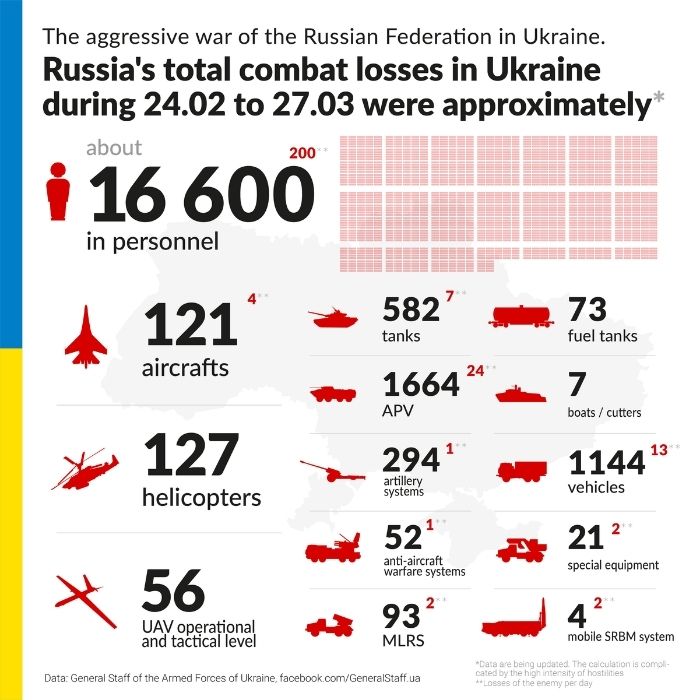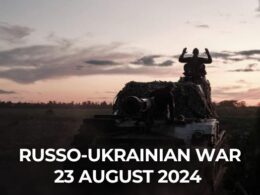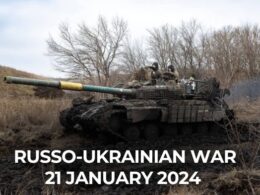The report is based on media reports, expert analyses, and official information posted online.
Situation

According to information from the General Staff as of 06.00 27.03.2022, supplemented by its [midnight assessment]:
[The enemy did not carry out offensive operations in the Volyn direction. Units of the Armed Forces of the Republic of Belarus are conducting combat training activities at five training fields in the Brest, Minsk, and Grodno regions.
[The enemy did not conduct active offensive operations in the Polissya direction. It fired on units of the Defence Forces, on residential areas in the suburbs, and directly on the city of Kyiv.]
- [According to the available data, certain units of the 35th Combined Arms Red Banner Army of the Far East Military District of the Russian Ground Forces, which suffered significant losses during the offensive, are being regrouped. Several units were assigned to the Chornobyl area with the subsequent relocation to the territory of the Republic of Belarus, aiming to restore combat capability. It is possible that after the implementation of these measures, regrouping, and strengthening of the occupying forces, the occupiers will resume actions to block Kyiv from the south-western direction.]
[In the Siversky direction, the enemy did not conduct an active offensive by the forces of the Central Military District. It tried to focus its main efforts on consolidating and maintaining the previously occupied borders. It did not stop trying to blockade the city of Chernihiv by separate units of the 41st Combined Arms Army and the 90th Guards Tank Division of the Central Military District. It continued shelling residential neighborhoods in the areas of Chernihiv, Ivanivka and Nizhyn.]
- [Probably, forces up to the company tactical group of units of the Armed Forces of the Russian Federation and the Russian National Guard, it is trying to keep the city Slavutych. The Russian occupiers set up checkpoints at the entrances to the city.]
[In the direction of Brovary, enemy units were stopped. The enemy was forced to move to the defence, carrying out engineering equipment positions. As a result of hostilities in the Lukyanivka and Rudnytske districts, units of the BTGr of the 30th separate motorized rifle brigade suffered significant losses and withdrew to the settlements of Pisky and Nova Basan.]
- [To make up for the loss of weapons and equipment, columns were marked in the directions of the settlements of Velykyi Sambir, Deptivka, Holinka, and in the direction of Dubovyazovka. Helicopters covered the columns from the air.]
- [Measures to strengthen the protection of the rear areas and logistics routes, as well as measures to strengthen the administrative and police regime in the temporarily occupied area are being taken.]
[In the Slobozhansky direction, the enemy acted with the help of separate units from the Western Military District and the Northern Fleet.]
- [In the direction of Sumy, the enemy did not conduct active offensive forces by units of the 1st Tank Army. Its main efforts were focused on the regrouping of troops.]
- [In the area of the city of Kharkiv, the occupiers did not carry out active offensive operations. The main efforts were focused on replenishing current losses, restoring equipment, and striking on the city's civilian infrastructure.]
- [In the direction of Sloviansk, the enemy is acting with forces of up to three Batallion Task Groups, trying to gain a foothold in the areas of the settlements of Kamyanka, Sinichyne, Sukha Kamyanka.]
- [It is noted that reconnaissance units are conducting ground reconnaissance in the direction of the settlement of Barvinkove and, probably, in the direction of the city of Sloviansk.]
[In the Donetsk direction, the enemy continues to regroup and build up strike groups to resume offensive operations in order to reach the administrative borders of Donetsk and Luhansk oblasts. The main efforts are focused on taking control of the settlements of Popasna, Rubizhne, access to the areas of settlements Vugledar, Novotroitske, as well as the capture of the Hero city of Mariupol
.]
- [In Rubizhne, with the support of artillery, it held positions in the northern and northwestern parts of the city.]
- [In Popasna, with the support of artillery, it tried to carry out assault operations, which was unsuccessful, and the enemy suffered losses. Due to the lack of cooperation, it fired mortar fire at its own positions.]
- [In the direction of the settlement of Krasnohorivka it made attempts to start assault operations.it was not successful. It suffered losses and left.]
- [It continues to storm Mariupol, inflicts air and artillery strikes on civilian and military infrastructure. It is not successful.]
[No changes in the depot and position of the enemy were recorded in the Tavriya direction.]
[In the direction of Mykolayiv, the occupation units continue to conduct reconnaissance and try to inflict fire on the positions of units of the Armed Forces of Ukraine.]
According to available information, in the temporarily occupied territory of the Autonomous Republic of Crimea, an average of 50 to 100 wounded personnel come to medical institutions in the city of Sevastopol every day.
The moral and psychological condition of the enemy troops remains low.
Along the paths of movement of Russian military columns on the territory of the Republic of Belarus, there are many facts of servicemen selling fuel and provisions their exchange for alcoholic beverages.
[According to the available information, in order to solve the problems of logistical support of the occupation groups on the territory of Ukraine, up to 9 battalions of logistics and up to 5 main logistics centres have been deployed.]
The occupiers continue to terrorize and intimidate the local population in the temporarily occupied territories. There are many cases of looting, theft of people and property.
In the Donetsk and Luhansk Oblast, the Allied forces repulsed 7 enemy attacks. Ukrainian soldiers destroyed 8 tanks, 8 units of armoured and 3 - enemy vehicles, one mortar. Losses of invaders in manpower are specified.
The Air Force of the Armed Forces of Ukraine has shot down 1 plane, 12 UAVs of various types, and 2 cruise missiles in the previous day.
The Air Force of the Armed Forces of Ukraine was used to cover troops and facilities. The strike aircraft dealt devastating blows to the commanders' targets and targets.”
It's clear that the offensive momentum of Russia has mostly stalled, in the past week there has been very little movement other than to reestablish control over supply lines that had been lost and a push towards the city of Kryvyi Rih
These arrows are movements over the last week pic.twitter.com/KtOdAyBDck— Nathan Ruser (@Nrg8000) March 24, 2022
Temporarily occupied territories of Georgia, Abkhazia, and South Ossetia are joining Russia to fight against Ukraine, according to authorities of the “republics”, the Washington Post reports.
On the evening of 26 March Lviv suffered several rocket strikes carried out by Russian troops, Ukrainska Pravda reports. An industrial fuel storage facility has caught fire and is currently burning.
The Bosphorus was temporarily closed in both directions due to a mine report, AA reports. The mine was neutralized and the strait was reopened Saturday 26 March.
According to British Defence Intelligence, (last 24 hours):
- Russian air and missile forces continue to strike targets across Ukraine including many targets in densely populated civilian areas.
- Russia continues to rely on “stand-off” munitions launched from within Russian airspace, in order to reduce their aircrafts’ exposure to Ukrainian air defense forces.
- US reporting of up to 60% failure rates of these weapons will compound Russia’s problem of increasingly limited stocks forcing them to revert to less sophisticated missiles or accepting more risk to their aircraft.
As of Sunday 27.03.2022, the approximate losses of weapons and military equipment of the Russian Armed Forces from the beginning of the war to the present day:

- personnel – more than 16,600 people (+200),
- tanks – 582 575 units (+7),
- armoured combat vehicles – 1664 units (+24),
- artillery systems – 294 (+1),
- multiple rocket launchers – 93 (+2)
- air defence means – 52 (+1),
- aircraft - 121 (+4),
- helicopters - 127 (no change),
- automotive technology – 1144 (+13),
- vessels/boats - 7 units (no change),
- fuel and lubricant tanks – 73 (no change),
- UAV operational and tactical level – 56 (no change)
- Special equipment – 21 (+2)
- Mobile SRBM system – 4 (+2)
Humanitarian
3,772,599 refugees have been registered as of 25 March, according to UNHCR. The UN says that so far Poland has taken in 2,236,314 refugees, Romania 579,800, Moldova 379,204, Hungary 342,738, Russia 271,254, Slovakia 267,702 and Belarus 6,341.
OHCHR has recorded 2,858 civilian casualties as of midnight 25 March: 1,104
killed (including 96 children) and 1,754 injured (including 123 children).
More than 3 million people have been evacuated and 9,000 tons of humanitarian aid have been transported by Ukrainian rail since February 24, European Pravda reports. 54 Ukrainian railway workers have been killed, 64 wounded and 3 abducted by Russian forces during the same period.
All 10 agreed humanitarian corridors worked to enable the evacuation of 5208 civilians from Donetsk (including Mariupol), Luhansk, and Kyiv Oblast. 80 tons of humanitarian aid were delivered, Deputy-Prime-Minister - Minister of Reintegration of Temporarily Occupied Territories of Ukraine reports.
Ukraine received a record 10.3 thousand tons of humanitarian aid on March 24, the largest daily amount of cargo since the beginning of the Russian invasion. During the last three weeks (March 4-24), 134.5 thousand tons of humanitarian aid were delivered to Ukraine. This is an average of 6.5 thousand tons per day.
Environmental
As a result of hostilities, the level of radioactive air pollution is increasing. Russian forces are destroying the ecosystems of the Chornobyl Exclusion zone, according to the Ministry of Environmental Protection and Natural Resources. 10,111 hectares have been destroyed by fire as of March 26.
NASA satellite images and the European Space Agency (ESA) are helping to capture major fires today. However, due to the limitations of remote sensing data currently used by our experts, we do not exclude the possibility of the existence of a significant number of smaller fire sources. Currently, satellite data provided by NASA and the European Space Agency (ESA) indicate the occurrence of 31 outbreaks of large fires in natural ecosystems and abandoned villages of the Exclusion Zone, covering a total area of over 10,111 hectares.
The personnel at Zaporizhzhia Nuclear Power Plant (ZNPP) are under constant psychological pressure due to the presence of Russian military units on the NPP site since 4 March 2022, the Ukrainian State Nuclear Regulatory Inspectorate (SNRIU) reports. Two ZNPP units are operating at power, the rest are under repair and in standby mode. According to information received from the ZNPP management:
- personnel continues monitoring the status and ensuring their safe operation following the requirements of the operating procedures.
- the NPP operation is carried out exclusively by Zaporizhzhia NPP personnel, and constant rotation of personnel is ensured.
- no changes in the radiological situation at the NPP site, in the control area, and observation area have been registered.
NSI “Neutron Source”, as well as any other nuclear installation, is not designed for operation in conditions of combat operations, SNRIU warns. Continuation of bombing and/or shelling can lead to severe radiation consequences and contamination of the surrounding territories. NSI “Neutron Source” is a nuclear subcritical installation situated in the National Science Center of Kharkiv Institute of Physics and Technology. The nuclear installation has been transferred into a “long-term shutdown” mode since 24 February 2022 and is being monitored. The power supply is lost due to the constant shelling of the adjacent territories and there is no possibility of restoring it. The radiation situation is within the standard limits.
Legal
136 children have been killed and more than 199 children injured since the invasion started, according to the Office of the Prosecutor General of Ukraine and the Ministry of Internal Affairs of Ukraine. It is still impossible to establish the actual number of dead and wounded due to the ongoing combat operations.
As of March 26, 570 educational institutions have been damaged, 73 of which have been completely destroyed. The occupiers also damaged at least 59 buildings of spiritual significance in 8 regions of Ukraine.
Twelve journalists have been killed since the Russian invasion of Ukraine, Prosecutor General Irina Venediktov said.
Russia might be using thermite incendiary submunitions near Avdiivka, BuzzFeed News correspondent Christopher Miller reports.
Overall registered numbers of crimes: 2869 crimes of aggression and war crimes, and 1696 crimes against national security.
Support
At a meeting with Ukrainian Foreign and Defense Ministers, US President Joe Biden assured that US support would continue until Ukraine's victory. Ukraine Will Win the War with Russia said President Biden to Ukrainian Minister, European Pravda reports.
“According to Kuleba, the talks demonstrated that the American president clearly understands what we have been talking about since 2014 - this is not Russia's war against Ukraine, but a war of tyranny against the free world."
“Baguette-sized flying bombs” are about to enter service in Ukraine, The Economist reports. Their operators will be able to pick the best target in real-time.
“Switchblade is a miniature aircraft—a drone—with wings that flip out after launch (hence its name) and an electric propeller which drives it forward at a leisurely 100kph for a flight that can last up to 15 minutes. It is controlled using a tablet that displays videos from an optical camera and an infrared thermal imager that are onboard the craft. When the operator spots a target, he or she locks onto it and the drone accelerates towards it at up to 160kph, chasing it automatically if it takes evasive action. Robert Bunker, director of research and analysis at c/o Futures, a security consultancy in California, says that the precision thus offered allows Switchblade to focus on high-value targets: not just artillery, but the headquarters and command vehicles of artillery units. The close-up view provided by the camera and thermal imager means that targets can be picked with care.”
Ukraine hints at a deal with the United States on an anti-missile defence system, European Pravda reports. Ukrainian Foreign Minister Dmytro Kuleba has hinted at an agreement on "concrete steps" to reduce the number of Russian missiles hitting facilities in Ukraine. This was announced by Minister Dmytro Kuleba after talks with the US delegation led by President Biden, in Warsaw.
George Freeman MP, Minister for Science, Research & Innovation, announces UK government response with £3 million a package to support Ukrainian researchers at risk. Science is an overwhelming force for peaceful cooperation. Through free and open academic discourse we can deliver benefits for humanity and the globe as we seek to address the most pressing challenges of our time. The government has also decided to suspend publicly funded research and innovation collaborations with Russian Universities and companies of strategic benefit to the Russian state.
New developments
- Negotiations continue. Ukraine insists on a system of security guarantees, advisor to the Head of the President's Office Mykhailo Podoliak said. "Ukraine insists on a system of security guarantees, which will include countries that are ready to provide these guarantees, including in the military sense. Many other things depend on it," he stressed. This is impossible without the participation of the USA. He noted that there is some progress in the negotiations but in general the progress is not yet what the Ukrainian side would like it to be. Podoliak believes that the peace talks will begin to yield fruit when Russia realizes that it will suffer more losses from the continuation of this war than Ukraine.
"For this to happen, we need the effective operation of our army. And this requires that our partners help us adequately. If you do not want to make a no-fly zone, give us air defense systems so that we can close the skies ourselves, so that our peaceful cities are not bombed. Second, give us weapons to unblock cities like Mariupol. Third, sanctions such as the oil embargo, maximum restrictions on financial transactions, etc. are needed,” Mykhailo Podoliak explained. - Zelensky renews his call for planes and tanks from NATO, The New York Times reports. President Volodymyr Zelensky said European leaders were falling short in helping his nation fight Russia and urged them to show even a bit of the courage that the outmanned residents of Mariupol have demonstrated. He renewed his public appeal to NATO for military equipment.
- On Saturday, the US president said in his speech in Poland that Russian President Vladimir Putin "cannot remain in power", TASS reports. Kremlin Spokesman Dmitry Peskov has said that it is not for US President Joe Biden to decide who should be in power in Russia. The White House stated that Biden had not called for regime change in Russia.
- Azerbaijan’s Armed Forces have entered the zone of responsibility of the Russian peacekeeping mission in Nagorno-Karabakh and launched four Bayraktar TB2 drone strikes, the Russian Defense Ministry said in a statement on its website, TASS reports. The Republic of Azerbaijan actively insists on the withdrawal of Russia-facilitated Armenian troops from disputed territories, also requiring them to admit the Nagorno-Karabakh region as solely Azerbaijanian territory.
- Ukraine would benefit from other opened fronts, Secretary of the National Security and Defence Council of Ukraine stated. He also mentions that [since Nagorno-Karabakh introduced martial law on its territory today, Armenia appealed to Russia requiring support with troops. But Russia withdrew its troops from that region and sent them to Ukraine last week. Today, the aid promised by Russia to Nagorno-Karabakh and Armenia is unlikely to appear.
- Turkish President Recep Tayyip Erdogan said he expected to hold telephone talks with President Putin to discuss the outcome of the NATO summit, TASS reports. "Today I will have talks with [Ukrainian President Vladimir] Zelensky. Perhaps I will have talks with Putin again this weekend or at the beginning of the next week."
Assessment
On the War
The Institute for the Study of War has made the following assessment as of Saturday 26 March:
, to fight for positions on Kyiv’s outskirts, and to attempt to complete the encirclement and reduction of Chernihiv.
Russian activities around Kyiv show no change in the Russian high command’s prioritization of the fight around Ukraine’s capital, which continues to occupy the largest single concentration of Russian ground forces in Ukraine. The Russians have not claimed to redeploy forces from Kyiv or any other part of Ukraine to concentrate on fighting in Donbas, and we have observed numerous indicators that they have not done so. The increasingly static nature of the fighting around Kyiv reflects the incapacity of Russian forces rather than any shift in Russian objectives or efforts at this time.
Russian forces will likely bisect the city of Mariupol in the coming days as they claim and will likely gain control of the city in the relatively near future. Fighting in Mariupol continues to be fierce, however, and Russian forces continue to suffer significant losses. The amount of combat power the Russians will be able to harvest from Mariupol once they gain control of the city will determine whether the city’s fall will allow the Russians to launch renewed large-scale offensive operations in Ukraine’s east. It remains unclear how badly damaged Russian units fighting for Mariupol are—or how much more damage they will incur in completing the capture of the city—but high-profile casualties in elite and conventional Russian combat units such as the 810th Naval Infantry Brigade and the 150th Motorized Rifle Division, both of which have lost commanders in the past few weeks, suggest that losses in such units are high.
Ukrainian forces continue to conduct limited counterattacks across the theater, most recently near Kharkiv. Ukrainian counterattacks have been prudent and effective, allowing Ukrainian forces to regain small areas of tactically or operationally significant terrain without over-extending themselves.
Key Takeaways
- Russian forces continue their unsuccessful efforts to secure positions from which to attack and seize Kyiv despite the supposed reframing of the Russian military’s priorities by First Deputy Chief of the Russian General Staff Sergei Rudskoi on March 25.
- The Russians will likely make important progress in seizing the city of Mariupol in the coming days and will probably take the city in the near future. The scale of Russian losses in the fight for Mariupol will determine whether the city’s fall will permit Russia to renew large-scale combat operations in eastern Ukraine. It is too soon to tell, but current indicators suggest that Russian losses have been and will continue to be high.
- The Ukrainian General Staff continues to report on challenges Russia faces in finding both troops and equipment to continue the war. The General Staff reports generally match observed patterns and indicators within the Ukrainian battlespace and are likely largely accurate, although we have little independent verification of their details.
- The captured city of Kherson appears to be resisting Russian control in ways that are driving the Russian military and national guard to concentrate forces on securing it. The requirement to secure captured cities can impose a significant cost on over-stretched Russian forces and hinder their ability to conduct offensive operations.”
Ukraine’s Defense Intelligence Chief Warns of “Real Hell” for Russians in an interview published by The Nation. The following are extracts of the text:
He was disinclined to trust the Russians -“the Russian side has never been predictable in a case of negotiations” - and struck a defiant note: “Our country understands with whom we are dealing, and we don’t expect any miracle here. We are dealing with an army of criminals, looters, mercenaries, and we are ready to fight and win.”
“Russian command has made miscalculations many times, and we use these miscalculations,” Budanov said. “The Ukrainian army has shown that the Russian army as the second army in the world is a big myth, and it’s just a medieval concentration of manpower, old methods of warfare.” […]
One of the keys to the Ukrainian forces’ effectiveness in the current conflict, Budanov said, has been intelligence gathering. He averred that from the beginning, the Ukrainians had been prepared. “We have lots of informers within the Russian army, not only in the Russian army but also in their political circles and their leadership,” Budanov told me. “In November, we already knew about the intentions of the Russians, and you can see that everything came through. As for the date, it changed several times.” Budanov said that this intelligence meant the Ukrainians were prepared for an invasion. […]
The war has entered a new phase, Budanov said, one in which the Russians have begun to shell Ukrainian cities and avoid ground clashes (“Russians are cowards because they bombarded and shelled our peaceful people, our hospitals, our drama theatres, maternity houses”). […]
One of the key components of Budanov’s job has been to organize a force of guerrillas who will stay behind Russian lines. He wouldn’t say much about the force, except that it is “a very large number of people,” raising the prospect of a drawn-out insurgency like that in Afghanistan or Vietnam. He mentioned that hunters had been drafted into the group, and I thought about the Ukrainian woodsman who blew himself up near Chernihiv with a grenade rather than hand over a list of local hunters to Russian troops. “Our warriors, our servicemen, even our hunters will start hunting the aggressor, the Russian forces, with their rifles in the forests,” he said. “I should say that soon the spring will come, our forests will become green, and a real hell will open up for the aggressor.”
Consequences and what to do?
Is military assistance making a difference? The question is raised in the report “Military assistance to Ukraine since the Russian invasion” published on 23 March 2022 (House of Commons Library). It concludes:
The consensus among analysts is that the tactics employed by the Ukrainian armed forces in conjunction with the arms provided by NATO and other allies have had a significant effect on slowing the Russian military advance into Ukraine.
The Financial Times describes:
Ukraine’s success in repelling Russia’s initial plan for a lightning advance and capture of Kyiv and other major cities owes much to its army’s consistent ability to target and destroy vehicles, inflicting both heavy losses and large delays to advancing convoys.
It details how small groups of Ukrainian troops, often armed only with shoulder-launched, portable rocket launchers — thousands of which have been provided by western countries since the invasion began — have used their terrain and Russia’s tactics to their advantage, and “helped lead a resistance that has surprised even Kyiv’s closest backers in the west.”
The Ukrainian army’s “consistent ability to target and destroy vehicles, inflicting both heavy losses and large delays to advancing convoys,” has been central to frustrating Russia’s initial plan to quickly advance and capture major cities. The widespread use of troop-carried, shoulder-fired anti-tank missiles, such as the US-made Javelin, and UK-supplied NLAWs, have been critical to these tactics.
However, the Russian military also appears to have changed tactics in the last few weeks increasingly turning to targeting civilians and attacking cities with artillery and long-range missiles. The arms supplied by NATO and other allies so far may do little to protect Ukrainian citizens from these bombardments or degrade the Russian forces launching them.
The Ukrainian Government are still asking for further military support, and for its allies to provide heavier and more lethal weapons.
In an interview with the Economist magazine on 22 March, Ukrainian Foreign Minister, Dmytro Kuleba, said:
We always realised that there would be no country fighting shoulder to shoulder with us, that it would be the cross that we have to bear. But to help us, countries can do two things: send us necessary weapons and impose sanctions.
Asked about Western partners' hesitancy to send bigger-ticket items such as tanks, armoured vehicles or planes, and their governments’ worries about moving beyond what they call defensive weapons systems, Mr Kuleba argues:
“Every weapon that is being used by the Ukrainian army in the territory of Ukraine is a defensive weapon by definition.”
He argued further that:
Those who make up these artificial divisions in their minds—we can give this, but we cannot give that—they only extend the suffering of Ukrainians, they contribute to the toll of dead civilians, and they only facilitate the further destruction of Ukrainian cities and villages. More weapons may be insufficient if the conflict continues.
Nick Reynolds, the Land warfare research analyst at RUSI, argues that:
The Ukrainian military needs further professionalisation, reform and training and if it “survives the next few days, weeks and months, international assistance will inevitably have to widen from immediate technical capability concerns to institutional inefficiencies and frictions once again.”
ME: The last paragraph must surely have been taken out of context. You fight with what you have – including the knowledge and experience – you have. The latter has, however, very limited value without weapons.
As both the Russian strategy and the situation on the ground is changing, the tactical advantage of the shoulder-fired anti-tank missiles, such as the US-made Javelin, and UK-supplied NLAWs, or the Stinger anti-air system. The Russian forces in some areas have dug in and are no longer on the move, and therefore far less vulnerable to the weapons. Russian forces are avoiding ground clashes and are instead relying on air and missile strikes, indiscriminate bombing and artillery shelling to inflict damage to both the Ukrainian Armed Forces and the civilian population.
The introduction of loitering ammunition (Switchblade) will slightly alleviate the situation. The numbers pledged so far, however, means that they unfortunately will have a very limited impact.
The West should take President Zelensky’s words to heart as he again called for planes and tanks from NATO, President Zelensky said European leaders were falling short in helping his nation fight Russia and urged them to show even a bit of the courage that the outmanned residents of Mariupol have demonstrated.
“One percent of the alliance’s tanks and planes. We did not ask for more, and we do not ask for more, he said. And we have already been waiting for 31 days. The price of the security is planes, tanks, missile defence systems and anti-ship weaponry. This is what our partners have that is covered with dust at their storage facilities," he said.





